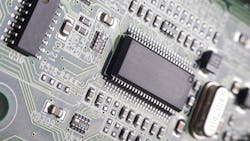On Monday, June 1, computer processor company Intel announced that it will buy Altera, one of the two primary vendors of field programmable gate arrays (FPGAs). Intel will spend nearly $17 billion in cash for Altera. The two companies already have a working relationship as Altera builds some of its FPGAs in Intel semiconductor fabrication facilities.
FPGAs Trump CPUs
Generally, Intel’s processor chips and Altera’s special programmable (in a different way) circuits are quite different and are used in different, though possibly adjoining, spaces. Gate arrays can perform functions 10 times as fast as instruction sequences running through clocked processors, but the processors are far more flexible than FPGAs. FPGAs are a nice middle-ground between instruction-set processors and hard-wired circuitry, but they come at a cost of high price and high power, each with mitigating conditions.
When digital signal processors (DSPs) were the rage, FPGAs ate at that market’s top end, offering much higher performance (with the price). FPGAs have fared well in cellular base stations since so many calls must be handled and there’s plenty of power available. FPGAs can process digital images (still and moving) much faster than traditional processors, but their power consumption makes them wrong for battery-powered cameras. Recently, FPGAs have been attractive to server farms and data centers where their high performance can be shared for dedicated purposes searching, serving, and maybe streaming data. Those data centers are where Intel becomes quite interested.
Key to all of these applications is the benefit for the highest performance for operations that can be well implemented in dedicated logic circuitry. Critical to the applications is the ability to supply sufficient power to the system while remove the resulting heat plus the justification of the higher cost of the semiconductor chips to gain that performance.
The word “programmable” is associated with both processors and FPGAs, but a processor is essentially infinitely reprogrammable, changing what it is doing millions of times a second, whereas an FPGA is more typically reprogrammed only a few times.
Imagine Intel in FPGAs
Intel is highlighting the use of FPGAs as an advantage to speed up operations in the data center. For one company, Intel, to be able to offer both the central processor and some FPGA chips may help bundle the components for the OEM. At this moment it is not known whether or when these will be separate semiconductor chips in a single package as Intel has done in the past with memory, accelerators, and networking add-ons or whether it makes technical, manufacturing, economic, or business sense to integrate the functions on a single piece of silicon. Perhaps if x86 processors share silicon with FPGA fabric, Intel’s “IA” moniker for “Intel Architecture” can stand for “Intel-Altera” as well.
One would expect that over time (maybe two to three years) Intel will produce processors containing hardware and software mechanisms that connect them tightly with FPGA blocks. Those FPGA blocks may be populated with the right combinations of logic for accelerating data searches, Web page serving, video streaming, compression, encryption, networking, and other specialized but evolving functions.
Intel with FPGA in its pocket has some advantages, certainly to Intel. Like server processors, FPGAs are a high-margin business; this is certainly more comfortable to Intel than the highly competitive and low-power ARM processor business. The FPGAs can add to the high-performance persona of Intel products—rightly so. And while it's not one-stop-shopping, every salesman (and some buyers) wants more usable products in their bag to sell/buy.
For old Altera, its FPGAs will surely soon be more finely tuned to the most advanced fabrication technologies, which are a bedrock of Intel. This should give Altera (then Intel) FPGAs one type of advantage over the competition, Xilinx—which has held its own in FPGAs (tussling with Altera, each with market share bouncing between 30% and 45%) and may find new opportunities with OEMs that are shy or unhappy with the behemoth Intel.
New Intel FPGAs may lean too much toward server and data-center purposes for other applications; Xilinx FPGAs may be more appropriate in the others. Buying an Intel FPGA would likely subject the OEM to heavy pressure to use X86 processors whether they fit historically, naturally, or otherwise. Changing processor architectures is a monumental effort, not undertaken lightly or without risk. Bundle pricing of FPGA and X86 may be a tempting sway, even—or especially—if they are the highest-priced semiconductors in the system. But oh, the engineers and programmers may scream. All of this is fair game, though perhaps frustrating. Ultimately, an interesting question is what does Xilinx do when its life-long evenly matched tormentor is now encased in Intel?
The Real Motivation?
On the other hand, Intel may also see picking up Altera’s FPGAs as a needed defense of its prime market. Intel was not Microsoft’s first choice for processors in Microsoft’s Bing search engine recently, having designed the Catapult project around FPGAs. There are rumors of other hyperscale companies similarly choosing not to use general-purpose processors for a very specific task (search, data mining, etc.), opting instead to build a custom processor out of a handful of FPGAs to do it. That could severely erode a very profitable business for Intel, possibly opening the floodgates for other companies to replicate this feat. By acquiring an FPGA firm, Intel can tap into the talent and architectures used by FPGA customers and may get insight to provide custom-tailored CPU instructions that perform as well as (or even better than) these hard-coded engines.
While Advanced Driver Assistance Systems (ADASs) are indicated by Intel as a prime target for the company once they have FPGAs, it is not clear to this analyst how the ADAS window opens up for Intel. Today’s ADAS designs are not likely to swing to X86 —even Atom—processors just because Intel now has Altera’ FPGAs. It may be that Intel gets the FPGA revenue rather than the prior Altera, but how other doors will fly open is unknown.
About the Author

Tom Starnes
Analyst
Tom Starnes is arguably the best-known embedded processor analyst in the semiconductor industry. Covering a range of products, Starnes' insight, coupled with his no-nonsense approach to processor and end-use analysis has led to his becoming one of the most sought-after consultants in the world of processors. It is through his hard-hitting insights that many key players in this industry have found their focus and refined their product strategies.

